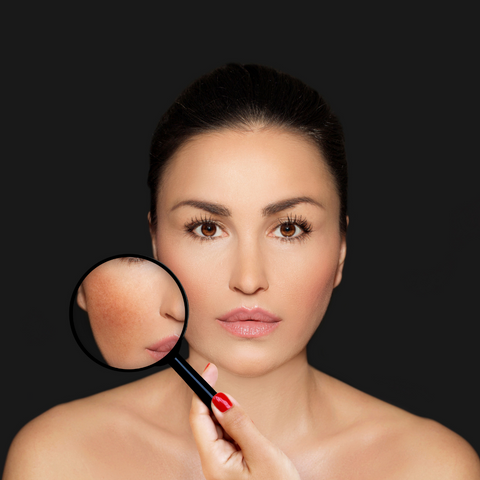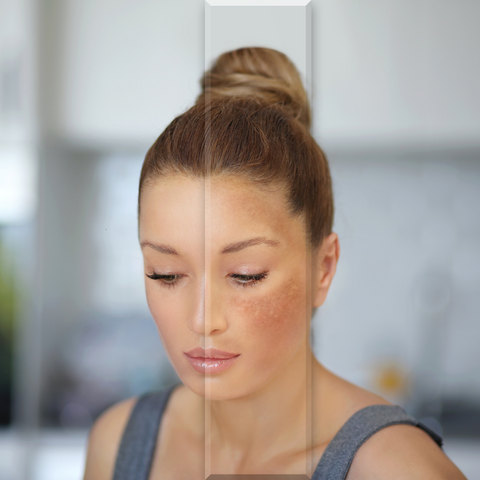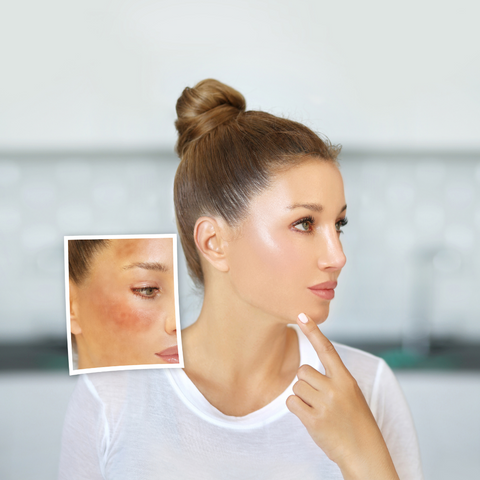What You Should Know About Hyperpigmentation?
Welcome to the Organic Skin Lightener for a comprehensive guide on hyperpigmentation. Hyperpigmentation, defined as darkened patches or spots on the skin, is a common problem affecting people of all ages and backgrounds. In this guide, we will look at hyperpigmentation's causes, types, symptoms, diagnosis, treatment options, prevention strategies, and related complications.

What is Hyperpigmentation?
Hyperpigmentation is a condition characterized by an excess of melanin, the pigment that causes skin coloration. The excess melanin causes darkened patches or spots on the skin, resulting in an uneven skin tone.
Types of Hyperpigmentation:- Melasma: Melasma is a common type of hyperpigmentation that appears as symmetrical brownish patches on the face, particularly on the cheeks, forehead, and upper lip.
- Post-inflammatory Hyperpigmentation (PIH): Dark spots or patches appear where there is an injury or inflammation on the skin, a condition known as photoaging of the skin (PIH).
- Sun-induced Hyperpigmentation: Sun-induced hyperpigmentation, also known as sunspots or solar lentigines, occurs after prolonged sun exposure, especially in areas exposed to sunlight.
- Age Spots (Solar Lentigines): Age spots, also known as liver spots or sunspots, are flat, brownish patches that appear on sun-exposed skin, such as the face, hands, and shoulders.
- Freckles (Ephelides): Freckles are small, flat brownish spots that appear on the skin as a result of genetics and sun exposure, especially in people with fair skin.
-
Drug-induced Hyperpigmentation: Certain medications, including hormonal contraceptives, antimalarials, and chemotherapy agents, can cause hyperpigmentation as a side effect.

Causes of Hyperpigmentation
- Sun Exposure: Prolonged exposure to ultraviolet (UV) radiation from the sun stimulates the production of melanin, which causes hyperpigmentation.
- Hormonal Changes: Hormonal fluctuations during pregnancy, menopause, or the use of hormonal contraception can cause hyperpigmentation, particularly melasma.
- Skin Inflammation and Injury: Acne, eczema, psoriasis, cuts, and burns can all cause post-inflammatory hyperpigmentation.
- Genetics: Some people are predisposed to developing certain types of hyperpigmentation, such as freckles or melasma.
- Medications: Certain medications, such as hormonal contraceptives, antimalarial drugs, and chemotherapy agents, can result in drug-induced hyperpigmentation.
- Skin Conditions: Acne, eczema, and psoriasis can all cause inflammation and post-inflammatory hyperpigmentation.
Risk Factors for Hyperpigmentation
- Skin Type: Individuals with darker skin types, particularly Fitzpatrick skin types IV-VI, are more prone to developing hyperpigmentation.
- Ethnicity: Certain ethnic groups, such as those of Asian, African, or Hispanic descent, have a higher risk of developing specific types of hyperpigmentation, such as melasma.
- Age: Hyperpigmentation becomes more common with age, particularly due to cumulative sun exposure over time.
- Gender: Women are more susceptible to hormonal-related hyperpigmentation, such as melasma, due to hormonal fluctuations during pregnancy, menopause, or the use of hormonal contraceptives.
-
Pregnancy: Pregnancy-related hormonal changes can trigger the development of melasma, also known as the "mask of pregnancy," particularly in women with a predisposition to the condition.

Symptoms of Hyperpigmentation
- Darkened Patches or Spots: The primary symptom of hyperpigmentation is the presence of darkened patches or spots on the skin, which may vary in size, shape, and distribution.
- Uneven Skin Tone: Hyperpigmentation can lead to an uneven skin tone, with areas of darker pigmentation contrasting with surrounding normal skin.
- Changes in Skin Texture: In some cases, hyperpigmented areas may exhibit changes in skin texture, such as roughness, dryness, or scaling.
- Psychological Impact: Hyperpigmentation can have a significant psychological impact on affected individuals, leading to feelings of self-consciousness, low self-esteem, and anxiety.
Diagnosis of Hyperpigmentation
- Physical Examination: Healthcare professionals typically diagnose hyperpigmentation through a thorough physical examination of the skin, including a visual inspection of the affected areas.
- Medical History: A detailed medical history, including information about past medical conditions, medications, hormonal changes, and sun exposure history, is essential for diagnosing hyperpigmentation.
- Wood's Lamp Examination: In some cases, a Wood's lamp examination, which uses ultraviolet light to detect changes in skin pigmentation, may be performed to aid in the diagnosis of hyperpigmentation.
- Biopsy: In rare cases where the diagnosis is uncertain or other skin conditions need to be ruled out, a skin biopsy may be performed to obtain a tissue sample for microscopic examination.
Treatment Options for it
a. Topical Treatments:
- Hydroquinone: Hydroquinone is a topical skin-lightening agent that inhibits melanin production and helps lighten dark spots.
- Retinoids: Topical retinoids, such as tretinoin or adapalene, can help improve skin texture and tone by promoting cell turnover and reducing melanin production.
iii. Vitamin C: Vitamin C serums have antioxidant properties and can help brighten the skin and reduce hyperpigmentation.
- Kojic Acid: Kojic acid is a natural skin-lightening agent derived from certain fungi and can help fade dark spots and even out skin tone.
- Azelaic Acid: Azelaic acid is a dicarboxylic acid that has both antimicrobial and skin-lightening properties and is commonly used to treat hyperpigmentation and acne.
b. Chemical Peels:
Chemical peels involve the application of a chemical solution to the skin to exfoliate the outer layer and promote skin regeneration, leading to a reduction in hyperpigmentation.
c. Laser Therapy:
Laser therapy uses high-energy light beams to target and destroy melanin-producing cells in the skin, leading to a reduction in hyperpigmentation.
d. Microdermabrasion:
Microdermabrasion involves the use of a specialized device to exfoliate the outer layer of the skin, promoting cell turnover and reducing hyperpigmentation.
e. Cryotherapy:
Cryotherapy involves the application of extreme cold to the skin to destroy excess melanin-producing cells, leading to a reduction in hyperpigmentation.
f. Intense Pulsed Light (IPL) Therapy:
IPL therapy uses broad-spectrum light energy to target and break down excess melanin in the skin, reducing hyperpigmentation.
g. Cosmeceuticals:
Cosmeceutical products containing ingredients such as niacinamide, licorice extract, and alpha hydroxy acids (AHAs) can help improve skin tone and reduce hyperpigmentation.
h. Natural Remedies:
Natural ingredients such as aloe vera, green tea extract, and lemon juice may have skin-lightening properties and can be used as complementary treatments for hyperpigmentation.

Prevention of Hyperpigmentation:
- Sun Protection: Sun protection is essential for preventing sun-induced hyperpigmentation. This includes wearing sunscreen with a high SPF, seeking shade during peak sun hours, and wearing protective clothing such as hats and sunglasses.
- Hormonal Management: Hormonal fluctuations can trigger hyperpigmentation, particularly in women. Managing hormonal changes through medications or lifestyle modifications can help prevent hormone-related hyperpigmentation.
- Gentle Skincare Routine: Adopting a gentle skincare routine that includes cleansing, exfoliating, and moisturizing can help maintain healthy skin and prevent inflammation or irritation that can lead to post-inflammatory hyperpigmentation.
- Avoiding Irritants: Avoiding harsh skincare products, abrasive scrubs, and chemical irritants can help prevent skin damage and inflammation that can lead to hyperpigmentation.
- Regular Exfoliation: Regular exfoliation helps remove dead skin cells and promote cell turnover, leading to a more even skin tone and reducing the risk of hyperpigmentation.
- Antioxidant Protection: Antioxidants such as vitamin C, vitamin E, and green tea extract help protect the skin from oxidative stress and UV damage, reducing the risk of hyperpigmentation.
Lifestyle and Home Remedies for Hyperpigmentation:
- Use of Sunscreen: Daily use of a broad-spectrum sunscreen with a high SPF is essential for protecting the skin from UV radiation and preventing sun-induced hyperpigmentation.
- Application of Topical Brightening Agents: Topical brightening agents containing ingredients such as niacinamide, licorice extract, and alpha hydroxy acids (AHAs) can help lighten dark spots and even out skin tone.
- Diet and Nutrition: Consuming a balanced diet rich in antioxidants, vitamins, and minerals can support overall skin health and help prevent hyperpigmentation.
- Stress Management: Stress can exacerbate skin conditions such as hyperpigmentation. Practicing stress-reduction techniques such as meditation, yoga, or deep breathing exercises can help improve skin health.
- Home Remedies: Natural ingredients such as aloe vera gel, green tea extract, and lemon juice may have skin-lightening properties and can be used as home remedies for hyperpigmentation.
Potential Complications of Hyperpigmentation:
- Psychological Distress: Hyperpigmentation can have a significant impact on an individual's self-esteem and quality of life, leading to feelings of self-consciousness, anxiety, and depression.
- Increased Risk of Skin Cancer: Prolonged sun exposure and UV radiation can increase the risk of skin cancer, particularly in individuals with sun-induced hyperpigmentation such as age spots or freckles.
- Chronic Inflammation: Post-inflammatory hyperpigmentation resulting from chronic skin conditions such as acne, eczema, or psoriasis can lead to persistent inflammation and skin damage.
- Secondary Infections: Darkened patches or spots on the skin can be more prone to bacterial or fungal infections, particularly in areas of friction or moisture buildup.
Seeking Professional Help for Hyperpigmentation:
- Dermatologist Consultation: Consulting a dermatologist is essential for accurate diagnosis and personalized treatment plans for hyperpigmentation.
- Esthetician Advice: Estheticians can provide professional skincare treatments and advice on managing hyperpigmentation, including chemical peels, microdermabrasion, and topical skincare products.
- Psychological Support: Psychological support from counselors, therapists, or support groups can help individuals cope with the emotional impact of hyperpigmentation and improve self-esteem and body image.
Future Directions in Hyperpigmentation Research:
- Novel Treatment Modalities: Ongoing research aims to develop new treatment modalities for hyperpigmentation, including novel topical agents, laser technologies, and targeted therapies.
- Targeted Therapies: Targeted therapies that specifically inhibit melanin production or target melanocytes without affecting surrounding skin cells are being explored for the treatment of hyperpigmentation.
- Precision Medicine Approaches: Precision medicine approaches that take into account individual genetic factors, skin type, and environmental influences are being developed to tailor treatment plans for hyperpigmentation.
- Advanced Diagnostic Tools: Advanced diagnostic tools such as molecular profiling, imaging techniques, and artificial intelligence algorithms are being developed to improve the accuracy and efficiency of hyperpigmentation diagnosis and treatment monitoring.
Hyperpigmentation and Mental Health:
- Impact on Self-esteem: Hyperpigmentation can have a significant impact on an individual's self-esteem and body image, leading to feelings of self-consciousness, embarrassment, and social withdrawal.
- Coping Strategies: Developing coping strategies such as positive self-talk, practicing self-care, and seeking support from friends, family, or mental health professionals can help individuals manage the emotional challenges of living with hyperpigmentation.
- Support Groups: Joining support groups or online communities for individuals with hyperpigmentation can provide emotional support, practical advice, and a sense of belonging to those struggling with the condition.
Hyperpigmentation in Different Ethnic Groups:
- Unique Challenges and Considerations: Different ethnic groups may have unique challenges and considerations when it comes to managing hyperpigmentation, including differences in skin type, cultural perceptions of beauty, and access to skincare resources.
- Cultural Perceptions: Cultural perceptions of beauty and skin tone vary across different ethnic groups, influencing attitudes towards hyperpigmentation and treatment preferences.
- Treatment Variances: Treatment approaches for hyperpigmentation may vary depending on individual skin characteristics, cultural background, and access to healthcare resources among different ethnic groups.
Hyperpigmentation and Aging:
- Age-related Changes: Hyperpigmentation becomes more common with age, particularly due to cumulative sun exposure over time and hormonal changes associated with aging.
- Management in Elderly Population: Managing hyperpigmentation in the elderly population may require special considerations, including addressing age-related skin changes, managing comorbidities, and minimizing the risk of treatment-related complications.
- Geriatric Considerations: Geriatric patients may have unique skincare needs and preferences, including concerns about skin fragility, medication interactions, and cognitive impairments that may affect treatment adherence.
Hyperpigmentation and Pregnancy:
- Hormonal Influences: Pregnancy-related hormonal changes can trigger the development of hyperpigmentation, particularly melasma or the "mask of pregnancy," due to increased melanin production and skin sensitivity to UV radiation.
- Pregnancy-related Skin Changes: Hyperpigmentation is common during pregnancy, with many women experiencing darkening of the nipples, areolas, abdomen (linea nigra), and face (chloasma or melasma) due to hormonal changes.
- Safety of Treatment Options: Certain treatment options for hyperpigmentation may not be suitable or safe for use during pregnancy due to potential risks to the developing fetus. It is essential for pregnant women to consult with healthcare professionals before undergoing any treatment for hyperpigmentation.
Hyperpigmentation and Gender Differences:
- Hormonal Factors: Hormonal fluctuations associated with gender-specific factors such as pregnancy, menopause, or the use of hormonal contraceptives can influence the development and management of hyperpigmentation.
- Social and Cultural Influences: Gender norms and societal expectations regarding appearance and skincare may influence attitudes towards hyperpigmentation and treatment-seeking behaviors among men and women.
- Treatment Response Variability: Gender differences in skin physiology and hormone levels may contribute to variability in treatment responses and outcomes for hyperpigmentation.
Hyperpigmentation and Chronic Skin Conditions:
- Psoriasis: Chronic skin conditions such as psoriasis can lead to inflammation and post-inflammatory hyperpigmentation, particularly in areas of active disease or skin trauma.
- Eczema: Eczema-related scratching and inflammation can result in post-inflammatory hyperpigmentation, with dark spots or patches forming at the site of skin lesions or irritations.
- Acne: Acne-related inflammation and skin trauma can lead to post-inflammatory hyperpigmentation, with dark spots or patches developing as acne lesions heal.
- Vitiligo: Vitiligo is a chronic skin condition characterized by the loss of skin pigmentation, resulting in white patches or depigmented areas on the skin. In some cases, hyperpigmentation may develop around the borders of vitiligo patches due to increased melanin production in surrounding skin.
Hyperpigmentation and Systemic Diseases
- Endocrine Disorders: Endocrine disorders such as Addison's disease, Cushing's syndrome, or thyroid disorders can affect hormone levels and metabolism, potentially leading to hormonal-related hyperpigmentation.
- Autoimmune Conditions: Autoimmune conditions such as lupus erythematosus or autoimmune thyroiditis can cause skin inflammation and pigmentation changes, leading to hyperpigmentation in affected individuals.
- Liver Disease: Liver disease, particularly conditions such as liver cirrhosis or hepatitis, can lead to the accumulation of toxins in the body and impaired liver function, resulting in skin discoloration and hyperpigmentation.
- Renal Dysfunction: Renal dysfunction or kidney disease can affect the body's ability to regulate electrolytes and waste products, leading to systemic imbalances that can manifest as skin changes, including hyperpigmentation.
Hyperpigmentation and Cosmetics
- Camouflage Techniques: Camouflage techniques involve using specialized makeup products or techniques to conceal hyperpigmented areas and achieve a more even skin tone.
- Makeup Products for Concealment: Makeup products such as color-correcting concealers, foundations, and powders can help camouflage hyperpigmentation and create a smoother, more uniform complexion.
- Skincare Products for Hyperpigmented Skin: Skincare products containing ingredients such as niacinamide, licorice extract, and alpha hydroxy acids (AHAs) can help improve skin tone and texture and reduce hyperpigmentation over time.
Conclusion
Treatment options and underlying causes for hyperpigmentation are diverse, making it a difficult skin disease. Through knowledge of the conditions' causes, signs, and risk factors, people can successfully treat and avoid hyperpigmentation. There are many methods for dealing with hyperpigmentation and getting a lighter, more even complexion, including topical treatments, professional interventions, and lifestyle changes.
At Organic Skin Lightener, we're committed to providing organic and effective solutions to improve skin health for individuals seeking to achieve luminous, radiant skin.

